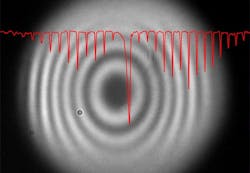‘Quantum ghost’ imaging captures previously invisible wavelengths
Photons can become entangled with one another upon creation; when this is the case, they are inextricably connected to each other in terms of properties—not simply across distances, but also across different wavelength ranges.
This entanglement is allowing Fraunhofer researchers working on the Quantum Methods for Advanced Imaging (QUILT) project to tap into photons to develop quantum optical solutions to get a glimpse into previously invisible wavelength ranges, which can provide valuable information in spectral regions beyond the visible range.
Short-wave ultraviolet radiation, for example, can be used to reveal the tiniest structures within cells. Infrared radiation can uncloak details about noxious gases within the air or the composition of plastics, according to the researchers. And long-wave terahertz radiation can be used to precisely determine the thickness of coating and paint layers. So quantum imaging shows potential within the fields of biomedical diagnostics, materials testing or processing, and environmental analytics.
One big quantum imaging challenge is that creating and detecting quantum light at these longer wavelengths requires significantly more resources than for light used in visible imaging techniques.
“There are many different quantum imaging techniques out there and they all have intriguing features,” points out Markus Gräfe, head of the Quantum-Enhanced Imagery Group within the Emerging Technologies Department at the Fraunhofer Institute for Applied Optics and Precision Engineering (Fraunhofer IOF; Jena, Germany).
Quantum imaging with undetected light “is one of the most fascinating options because quantum light can interact with a sample but isn’t detected,” Gräfe adds. “Instead, its ‘partner’ quantum light is detected and yields an image of the sample on the camera—even though it never interacts with the sample. That’s kind of spooky quantum imaging.”
The underlying principle is that while one photon has a wavelength that can be captured on camera, the other photon interacts with the object under examination within the visible range. Entanglement, dubbed by Einstein as “spooky action at a distance,” means the information gathered by the second photon is transferred to the first, which makes it visible to the camera.
While working on the QUILT project, the researchers demonstrated a new detection principle for terahertz radiation that may improve methods for exploring materials in the future.
To do this, they developed a quantum optical counterpart to the classical Fourier-transform infrared (FTIR) spectrometer, which is used within the realm of process analytics to examine gas samples. They then produced the first video known to be created via imaging with undetected light, and managed to capture and reconstruct the world’s first 2D image using “quantum ghost imaging” with asynchronous detection.
Ghost imaging is suited for biological and medical applications, the researchers say, in which light-sensitive cell samples can be observed during a long period of time because the new processes use less light.
“Many quantum imaging techniques should be considered, and our work at Fraunhofer IOF includes nonlinear interferometers for microscopy to enable the ‘spooky’ quantum imaging,” Gräfe says. “We envision a quantum scanning microscope with undetected light enabling imaging within extreme spectral ranges—such as mid-infrared—where detection is very challenging (or not possible) by detecting visible light only.”

Sally Cole Johnson | Editor in Chief
Sally Cole Johnson, Laser Focus World’s editor in chief, is a science and technology journalist who specializes in physics and semiconductors. She wrote for the American Institute of Physics for more than 15 years, complexity for the Santa Fe Institute, and theoretical physics and neuroscience for the Kavli Foundation.
